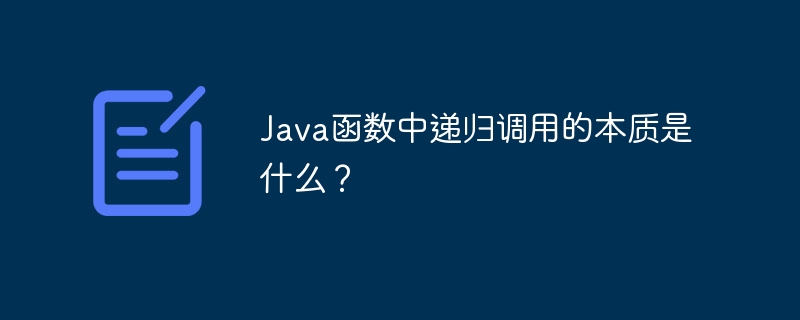What is the nature of recursive calls in Java functions?
Recursion in Java is essentially the function call itself. This call can be achieved by direct call or indirect call. A typical example of recursion is calculating factorial, which is done by calling itself repeatedly until a termination condition is reached. Another practical example is generating the Fibonacci sequence, which is calculated by calling itself indirectly and returning the sum of the first two numbers.

The essence of recursive calls in Java functions
Recursion, in computer science, refers to the process of a function calling itself within a function. In Java, recursive functions are implemented by calling themselves.
The essence of recursion
The essence of recursion is that a function calls itself. This call can be made in two ways:
- Direct call: The function calls itself directly.
- Indirect call: A function calls itself through another function.
Recursive example
The following is an example of a Java function that calculates factorial:
public static int factorial(int n) {
if (n == 0) {
return 1;
} else {
return n * factorial(n - 1);
}
}In this example, factorial The function calls itself directly to calculate the factorial. When n equals 0, the recursion stops and 1 is returned. Otherwise, the recursion continues, returning n times the factorial of n-1, and so on until n equals 0.
Practical Case: Fibonacci Sequence
The Fibonacci Sequence is a sequence defined by the following rules:
- before The two numbers are 0 and 1.
- Each subsequent number is the sum of the previous two numbers.
We can use recursion to calculate the Fibonacci sequence:
public static int fib(int n) {
if (n == 0) {
return 0;
} else if (n == 1) {
return 1;
} else {
return fib(n - 1) + fib(n - 2);
}
}In this example, the fib function indirectly calls itself and returns the first two The sum of Fibonacci numbers to calculate Fibonacci numbers. When n equals 0 or 1, the recursion stops and the corresponding value is returned. Otherwise, the recursion continues, returning the sum of the Fibonacci numbers of n-1 and n-2.
The above is the detailed content of What is the nature of recursive calls in Java functions?. For more information, please follow other related articles on the PHP Chinese website!

Hot AI Tools

Undresser.AI Undress
AI-powered app for creating realistic nude photos

AI Clothes Remover
Online AI tool for removing clothes from photos.

Undress AI Tool
Undress images for free

Clothoff.io
AI clothes remover

AI Hentai Generator
Generate AI Hentai for free.

Hot Article

Hot Tools

Notepad++7.3.1
Easy-to-use and free code editor

SublimeText3 Chinese version
Chinese version, very easy to use

Zend Studio 13.0.1
Powerful PHP integrated development environment

Dreamweaver CS6
Visual web development tools

SublimeText3 Mac version
God-level code editing software (SublimeText3)

Hot Topics
 Square Root in Java
Aug 30, 2024 pm 04:26 PM
Square Root in Java
Aug 30, 2024 pm 04:26 PM
Guide to Square Root in Java. Here we discuss how Square Root works in Java with example and its code implementation respectively.
 Perfect Number in Java
Aug 30, 2024 pm 04:28 PM
Perfect Number in Java
Aug 30, 2024 pm 04:28 PM
Guide to Perfect Number in Java. Here we discuss the Definition, How to check Perfect number in Java?, examples with code implementation.
 Random Number Generator in Java
Aug 30, 2024 pm 04:27 PM
Random Number Generator in Java
Aug 30, 2024 pm 04:27 PM
Guide to Random Number Generator in Java. Here we discuss Functions in Java with examples and two different Generators with ther examples.
 Armstrong Number in Java
Aug 30, 2024 pm 04:26 PM
Armstrong Number in Java
Aug 30, 2024 pm 04:26 PM
Guide to the Armstrong Number in Java. Here we discuss an introduction to Armstrong's number in java along with some of the code.
 Weka in Java
Aug 30, 2024 pm 04:28 PM
Weka in Java
Aug 30, 2024 pm 04:28 PM
Guide to Weka in Java. Here we discuss the Introduction, how to use weka java, the type of platform, and advantages with examples.
 Smith Number in Java
Aug 30, 2024 pm 04:28 PM
Smith Number in Java
Aug 30, 2024 pm 04:28 PM
Guide to Smith Number in Java. Here we discuss the Definition, How to check smith number in Java? example with code implementation.
 Java Spring Interview Questions
Aug 30, 2024 pm 04:29 PM
Java Spring Interview Questions
Aug 30, 2024 pm 04:29 PM
In this article, we have kept the most asked Java Spring Interview Questions with their detailed answers. So that you can crack the interview.
 Break or return from Java 8 stream forEach?
Feb 07, 2025 pm 12:09 PM
Break or return from Java 8 stream forEach?
Feb 07, 2025 pm 12:09 PM
Java 8 introduces the Stream API, providing a powerful and expressive way to process data collections. However, a common question when using Stream is: How to break or return from a forEach operation? Traditional loops allow for early interruption or return, but Stream's forEach method does not directly support this method. This article will explain the reasons and explore alternative methods for implementing premature termination in Stream processing systems. Further reading: Java Stream API improvements Understand Stream forEach The forEach method is a terminal operation that performs one operation on each element in the Stream. Its design intention is






